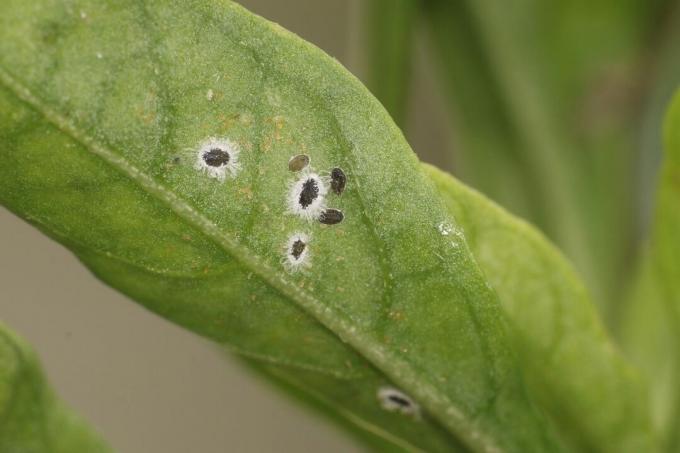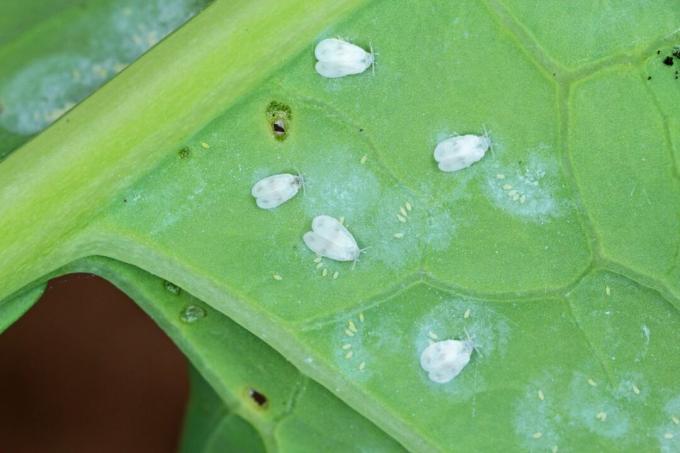Fighting whitefly naturally and biologically, is that possible? - Yes! And with Encarsia formosa. Because she lays her eggs in the larvae of the whitefly, causing them to die.

With the white fly, one might think that the name says it all. It is white and flies, but strictly speaking "fly" is the wrong term for the pests of the whitefly (Aleyrodoidea) family. But what can you do if you have this type of lice on your plants? Biological and sustainable control is possible: with the parasitic wasp Encarsia formosa. Here's how to recognize it, how to live it, why it's so effective, and how best to use it.
contents
- Encarsia formosa parasitic wasps: appearance and lifestyle
- Encarsia formosa beneficial against whitefly
- Procedure for use as a beneficial insect
Encarsia formosa parasitic wasps: appearance and lifestyle
Ichneumon wasps of the species Encarsia formosa are about 0.7 mm in size, so much smaller than the name "wasp" suggests and can hardly be seen with the naked eye. At first glance, the small beneficial insects have little in common with the wasps known from the garden. Only the color is similar, so have the female
Encarsia- Ichneumon wasps have a yellow abdomen and a black head and thorax, while the males have a purely black body. Both stinging wasps and parasitic wasps belong to the so-called stinging species (Apocrita), so they are actually related.To lay eggs, the females need the whitefly as a host, which they can parasitize with their eggs. Under optimal conditions, each female lays between 50 and 100 eggs in her lifetime. The larvae pass through various stages in the host, pupate and hatch as adult parasitic wasps about two weeks after laying their eggs.
originally comes Encarsia formosa from South and Central America. Nowadays, however, it is bred worldwide and used as an effective beneficial insect, especially against the whitefly.

Encarsia formosa beneficial against whitefly
The pressing question when it comes to pests is how best to combat them. The whitefly is a common pest in both greenhouses and indoor plants. For private users, beneficial insects and biological pesticides are usually the best option. Synthetic plant protection is primarily reserved for commercial horticulture because of the strict usage requirements and the risk for users and the environment. Therefore, this article primarily deals with the effective use of the proven ones Encarsia formosa- Ichneumon wasp against whitefly.
Advantages of beneficial insects over pesticides:
- No residues on the plants and in the soil
- No waiting times for harvest
- No damage to plants, humans and animals
- Unlimited use without special requirements also possible for private users
- High efficiency when used correctly
Next to Encarsia formosa there are other beneficial insects that can be used against whiteflies - for example predatory mites (Amblyseius), assassin bugs (Macrolopus ssp.) or lacewing larvae (Chrysoperla carnea). Here at Plantura we chose our Plantura Encarsia- Ichneumon wasps against whiteflies decided. And with good reason: The EncarsiaWhen used correctly, parasitic wasp is a very successful remedy against whiteflies and is therefore one of the most important beneficial insects worldwide. It is now standard in professional commercial horticulture.

How does the parasitic wasp fight the whitefly? the Encarsia- Ichneumonid wasp is so effective against whitefly because it fights almost all stages of development. The females lay their eggs in the last pupal stages of the whitefly. As a result of the parasitization, the whitefly dies and the puparium turns black. The adult parasitic wasp also sucks out the haemolymph – the blood of the insects – from the younger larval stages of the whitefly.
Encarsia formosa uses about 15 different species of whiteflies as hosts, including the two most important species Trialeurodes vaporariorum or greenhouse whitefly as well Bemisia tabaci, also called cotton whitefly.
Tip: Against the cabbage whitefly Aleyrodes proletella is the Encarsia- Ichneumon wasp not suitable as a beneficial insect, because it is not parasitized by it. In this case, the parasitic wasp species is suitable Encarsia tricolor or approved biological pesticides such as ours Plantura Pest Free Neem. It is gentle on beneficial insects and can be used on many ornamental and useful plants against stinging and biting harmful insects.

Procedure for use as a beneficial insect
Important when using our Plantura Encarsia- Ichneumon wasps against whiteflies is that these are applied promptly after the plants have been infested with whiteflies. If you choose our Plantura parasitic wasps, you will receive a total of 500 animals on ten cards. In other words, there are 50 animals on each card, which is enough for a total area of about 10 m². We recommend an application between March and October, as there is a sufficient amount of light available for parasitization. In order for the parasitic wasps to be able to take effective action against the whitefly, they must find good "working conditions". This includes the right humidity, sufficient light and an optimal temperature. If these parameters are not sufficiently met, whitefly control will be less successful.
In addition, the earlier pests in the plants are discovered and controlled, the less damage can occur. A monitoring of the infestation with the help of yellow boards like ours Plantura Yellow Boards therefore makes sense. In the case of frequent infestations, it makes sense, especially in the greenhouse, to spread parasitic wasps as a preventive measure. Thus, a pest infestation is prevented even before high infestation pressure. A success of the parasitic wasps can be clearly seen after about four weeks.
You can find everything about lifestyle and prevention and control with organic pesticides in our article on White bow tie read again.
Tip: Especially with tomatoes (Solanum lycopersicum), cucumbers (Cucumis sativus), eggplant (Solanum melongena) and some ornamental plants, the whitefly is often encountered. The eggs are always laid on the underside of the leaf in a semicircular or circular arrangement.

Use parasitic wasps against whiteflies:
- Timely ordering of the parasitic wasps after the infestation was determined.
- After receipt of the cardboard strips, apply quickly: Can be stored for a maximum of 2 days at 8 to 12 °C.
- To increase the success of the control, you can put all the plants together in one place and use the parasitic wasps there collectively.
- Do not open the packaging until you are at the point of use, otherwise any adult parasitic wasps that have hatched will escape.
- Optimum development of the parasitic wasps is achieved at a temperature between 22 and 27 °C and a light quantity of at least 4000lux; for orientation: a desk should be illuminated with 500 to 1000 lux; additional lighting can be useful.
- In order to achieve the necessary humidity of around 65%, the plants can be sprayed with water every 2 to 4 days.
- Pesticides should not be used while the parasitic wasps are being used, as they can damage the beneficial insects.
tip: We recommend deploying our Encarsia formosa only in closed rooms such as greenhouses, rooms or conservatories, since the beneficial insects migrate quickly outdoors and thus only insufficiently parasitize the pest infestation.
Would you like to fight whiteflies or other pests outdoors or on the balcony? Read our article about Neem for pest controlhow the herbal active ingredient works and is used.


